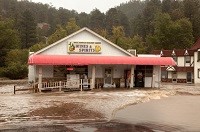Portions of our state have been devastated by flooding this fall, and for many the cleanup and recovery will take months, even years. While most people are acutely aware that many homes, farms, roads and other infrastructure was severely damaged or destroyed in this natural disaster, there is another element of the disaster that is less well known, yet equally destructive to the economic vitality of the affected communities: damage to businesses.
The damage to businesses goes far beyond the ruin of buildings and the loss of equipment and inventory—though businesses have plenty of that. There is also the ongoing impact of long-term closures, caused by damaged city infrastructure, lost employees who lose hope and leave town, and lost revenues from a customer base that can’t reach them. Indeed, the damage is so significant, many businesses will simply close their doors permanently. When these businesses close, the entire business community will suffer, jobs will be lost, homes will be foreclosed, people will leave town, neighborhoods will deteriorate, and more businesses will close, starting the whole cycle over again.
If we can get financial aid to these flood-damaged businesses, to help them keep their doors open, we can save the communities. Yet in the philanthropic world, there is still a notion that aid to businesses is not needed, possible or permissible—even in the midst of a disaster situation. In the past, the IRS stance was that businesses were not appropriate objects of charity. However, that changed in the aftermath of 9/11. It became clear that small businesses in the lower Manhattan “frozen zone” were suffering immensely as a result of the shutdown—regular customers and tourist foot traffic were essentially non-existent. And when these businesses could not stay afloat, there was a ripple effect, because they were owned by people who relied on that business income to pay their bills, and who employed other people.
Many advisors worked with the IRS and Congress post-September 11 to relax the IRS stance in this area. Essentially, what it comes down to is that aid to businesses, even direct aid in the form of grants, can be permissible. Colorado businesses and communities can benefit from this post-9/11 thinking. The IRS, in its publication focused on disaster relief, notes that disaster assistance can be provided to businesses to achieve the following charitable purposes:
- To aid individual business owners who are financially needy or otherwise distressed;
- To combat community deterioration;
- To lessen the burdens of government.
In addition, the publication is clear that a charity can accomplish a charitable purpose by providing disaster assistance to a business if (1) the assistance is a reasonable means of accomplishing a charitable purpose; and (2) any benefit to a private interest is incidental to accomplishment of a charitable purpose.
In the context of a natural disaster like the Colorado flooding, which can put the entire business district (and economic hub) of a town in jeopardy, aiding businesses at risk of closing their doors can help fight community deterioration. For each small business that can’t make it and closes its doors, there is an increasing chance that others may decide it is not worth it to reopen—and then you’ve got a town that’s in serious long-term trouble.
Other communities faced with natural disasters have instituted programs to assist affected businesses. For example, after Hurricane Sandy, the Manhattan Chamber of Commerce worked with business partners and its affiliated 501(c)(3) charity to raise and disburse grants to affected small businesses. And in Cedar Rapids, Iowa, the Chamber of Commerce worked with the 501(c)(3) community foundation to set up a combined grant/forgivable loan program for businesses affected by severe flooding in 2008. Program design varies, but guidelines should be in place that require businesses to be under a certain size (perhaps measured by number of employees, or annual revenue), be in an affected location, be able to demonstrate proof of loss of business, and indicate how the funds will be used. Grant amounts are generally based on need and will take into account potential proceeds from other sources, such as insurance. Businesses should be prepared to report or follow up on use of money, as well.
For the businesses, the grant proceeds likely will not be considered taxable income, but instead will be a nontaxable gift. The IRS looks at the facts and circumstances of each situation to ensure that the payment is not motivated by a moral or legal obligation or economic benefit, or made in return for services. However, guidance issued post-September 11 is instructive, and indicates that grant recipients cannot “double-dip” with respect to the funds. This means that, if a business gets a grant that is not included in income by virtue of being a non-taxable gift, and this grant is used to help meet payroll, the business cannot then deduct payroll expenses.
Bottom Line: The philanthropic community can help Colorado flood-damaged businesses stay viable, and in doing so, save individuals and communities. Some of our mountain towns are extremely difficult to reach because of damage to highways. In addition, other towns are faced with a demolished city infrastructure that leaves many businesses unable to open—even if the business was not seriously harmed by the flood waters. This is occurring during the height of the fall sightseeing season, when people normally would be head up to the mountains to hike or bike, see the changing leaves—and in the process patronize many businesses. Many of these businesses will need help as soon as possible—and it is important to remember that the IRS allows charitable organizations to give them that help!
Additional Resources:


